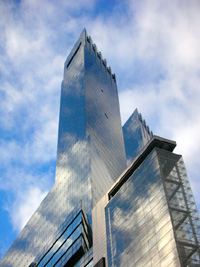Last night, the third and final concert of the Keys to the Future series featured pianists, Tatjana Rankovich, Joseph Rubenstein, Polly Ferman. Ms. Ferman, a noted tango performer, closed out the concert with a set of Argentine compositions, many of them inspired by the Tango.
Winged (1995) Bruce Stark (b. 1956)
Stark’s work has been featured in every concert of the series and for good reason. He has an unusually rare gift in creating a recognizable voice, combining compelling content with forms that make sense and are full of surprises. Winged, one of his first ‘acknowledged’ compositions did not fail to deliver in all of these regards. Inspired by the notion of flying angels, it began high in the clouds, aloft, shimmering and luminescent. For the full 10 minutes the piece continously explored impressionistic canyons and mountains with often beautifully static moments and without for a moment seeming cloying, minimalist or new-agey. Tatjana Rankovich admirably drove these pianistic ecstasies with aplomb and joy.
Ballade (2000) Sarah K. Snider (b. 1973)
Snider’s Ballade was a composition inspired by the 4th Chopin Ballade often employing polyrhythms (such as Chopin used in the last set of three etudes) and romantic musical devices while maintaining a contemporary harmonic palette. The piece would have been more sucessful if the material had more salient characteristics. The form was interesting and compelling throughout.
Toccata (2001) Pierre Jalbert (b. 1968)
Rankovich continued her blistering performances with Jalbert’s ragged and intense Toccata. An American composer from Vermont, the piece combined scalar motifs with powerful clusters in a thrilling manner. The violence however, never seemed formless and without intent, and often surprised with its variety of textures and discontinuities of motion.
Waltz (1997) Ricky Ian Gordon (b. 1956)
Gordon’s Waltz was intensely sentimental and beautiful, reminding one of Satie throughout its length, which was perhaps a little much. Rubenstein performed with varieties of pianissimo piano playing which were delightful.
Elegiac Cycle (3 selections) (1999) Brad Mehldau (b. 1970)
Jazz composer Brad Mehldau’s cycle was melodic without seeming overtly jazz-inspired but could have had a bit more variety in its accompaniment figures and textures.
Romance No. 1 (2006) Joseph Rubenstein (b. 1969)
Rubenstein performing Rubenstein was a delight in this world premiere, subtitled ‘river of night’. It is rare that one hears a pianist composer so technically accomplished. The piece was filled with intimate colors and varieties of quiet textures that charmed throughout.
Adios Nonino (1959, arr. 1975) Astor Piazzolla (1921-1992)
Uruguayan pianist Polly Ferman began her survey of recent Latin-American piano literature with tango innovator Piazzolla’s Adios Nonino a piece written directly after his father had died and full of deep sentiment. The varieties of textures always employed by Piazzolla did not disappoint, however there was a sense of the piece being a medley which was at times distracting. Ferman’s sensitivity to the genre was evinced throughout with her subtle rhythmic variations and emotional voicings.
Milonga Sureña (1979) Juan José Ramos (1930-1995)
Ferman began the next part of the concert with a brief talk about the Milonga, a faster and rural tango form. In Ramos’ Milonga, Polly Ferman’s dramatic and natural phrasing created a saucy and ferocious authenticity.
Milonga (from Aquel Buenos Aires) (1971) Pedro Saenz (1915-1995)
Saenz’s contribution to the genre was full of seconds and percussive effects that intensely demonstrated this tense and obsessive form.
Paris Desde Aqui (2001) Daniel Binelli (b. 1946)
Bandoneon master Daniel Binelli’s waltz was a musical depiction of the city of lights that suceeded admirably in creating a living cityscape.
Levante (2004) Osvaldo Golijov (b. 1960)
Golijov’s Levante closed the show with a vaguely deconstructed suite of Cuban rhythms morphing into a tango. While admirably interpreted, it demonstrated to this listener, the dangers of deconstruction. A composer cannot merely take apart – the important step is the reconstruction, the innovative way that the living material once decoded, is put back together into convincing newness. And as in Kline’s composition the night before, at the edges of complex rhythmic layering, the listener is often left with moments of metrical confusion produced by rote formulae.
All in all, a wonderful survey of recent and lesser known piano compositions, admirably performed throughout with attention and intense emotion.
 How about a nice round of applause for Jeff Harrington who blogged all three nights of the Keys to the Future Festival. Bravo, well-done and many thanks for giving me an excuse to focus on more lucrative (hopefully) projects this week and to gloat over certain current events. I refer, of course, to the beginning of the return to sanity of American government and the exciting Rutgers victory over Louisville. When West Virginia knocks off Rutgers on December 2, revenge will be complete.
How about a nice round of applause for Jeff Harrington who blogged all three nights of the Keys to the Future Festival. Bravo, well-done and many thanks for giving me an excuse to focus on more lucrative (hopefully) projects this week and to gloat over certain current events. I refer, of course, to the beginning of the return to sanity of American government and the exciting Rutgers victory over Louisville. When West Virginia knocks off Rutgers on December 2, revenge will be complete. 
